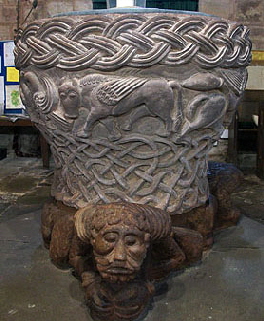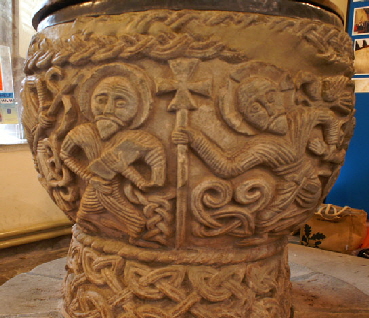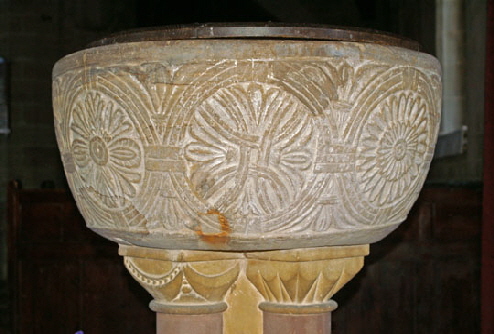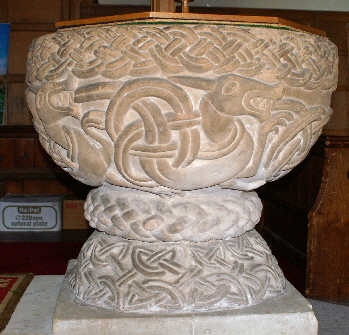|
Alphabetical List |
|
|
|
|
|
|
|
County List and Topics |
|
|
|
Please sign my Guestbook and leave feedback |
|
You might have noticed that the county of Herefordshire, a rural county known mostly for cows and cider, has more than its fair share of parish churches featured on this site. If you have read these entries, you are probably used to references to the Herefordshire School of Romanesque Sculpture and possibly you might be a little bemused as to what this is and its significance. Let’s begin by stating the obvious: we are not talking of a “school” where people were taught. We are talking of a recognisable style of art - in this case sculpture - and, by implication, of a group of people who held similar artistic values and who were influenced by each other. That’s my own definition and I must apologise if it varies from the accepted one. You will come across the concept most often in visual arts. Often you will see paintings attributed to, for example, “The Norwich School” where the artist cannot be named but where the work conforms to the style and artistic values of a discrete group. It has to be admitted, however, that it is an expression that is used rather loosely. One might also add that it is perhaps also a little pretentious but we are going to have to live with it! The Herefordshire School operated in the first half of the twelfth century. Its work was consistently of the very highest quality. It epitomises everything that was best in English Romanesque decoration. It is vibrant and bold in both theme and execution. It drew on Christian dogma both popular and obscure. It uses pagan imagery that leaves us scratching our heads and looking for Christian allegory where probably none was intended. Its seems to draw its influences from all over Europe. Culturally this is surely one of the most important bodies of folk art in England, if not in Europe, yet few know of it and it gets no special protection or promotion from Britain’s country house and castle-obsessed conservators. Yes, I’m on my soap box again. I’m comfortable there! Confusingly, perhaps, the work of the Herefordshire School is to be found in some churches in Worcestershire and Shropshire as well as in Herefordshire! The principal writers on the subject are George Zarnecki and Malcolm Thurlby. Zarnecki was a Pole who remained in England after serving with the Free Polish Forces during World War II and went on to become a noted expert on the history of art - particularly Romanesque art. Malcolm Thurlby, citing Zarnecki as his inspiration, is, I believe, still Professor of Visual Arts at York University in Toronto. His book “The Herefordshire School of Romanesque Architecture” is now back in print and is the definitive work on the subject. I am indebted to his much-treasured book for for the precis offered here. In my own book, “Demon Carvers & Mooning Men” I talk about a group of masons who travelled about the East Midlands countryside in the late fourteenth or early fifteenth century leaving behind hundreds of carvings on parish churches, almost certainly largely of their own invention and with probably little detailed attention from their patrons. They were expanding and remodelling existing churches, not building them from scratch. The work of the Herefordshire School, however, was not mason-led but patron-led. The masons and sculptors were not modifying churches but building them. We are talking here of post-Conquest England. The Anglo-Saxon lords had been supplanted by Duke William’s men and their descendants. The invaders were intent on consolidating their hegemony. Castles - previously unknown in England - were the symbols of their secular power. The building of churches were symbols of their religious ascendancy. The churches we are talking of here did not belong to a “parish”; they were not commissioned by “The Church”. They were commissioned by the men who owned the villages that lay upon their land. Because we know who these men were we are able to know who was the patron of what church. These were not men who were just commissioning a building job. They were men who had great wealth and power and for whom the churches they built were a measure of their prestige, Malcolm Thurlby is thus able to name not the masons but their patrons: the likes of Hugh de Mortimer, and his agent Oliver de Merlimond, the Lacy family and Payn Fitz John, Ralph de Baskerville. Such men would have known each other and would have been rivals. Their families would have intermarried. These were the men who employed the masons of the Herefordshire School. They were not just the savage, ruthless men of English legend. They were men who had travelled Europe and seen the ecclesiastical buildings of modern Italy, Germany and France. They may have travelled to the Holy Land during the First Crusade of 1099. The churches that these patrons commissioned might, to our eyes, seem simple and crude compared with the excesses of the High Gothic periods. Thurlby, however, says that they were in fact the height of sophistication for their time and drew heavily on the architectural developments at Hereford and Gloucester cathedrals, amongst others. Let’s not forget, by the way, that some at least will have been replacing wood and that Anglo-Saxon buildings! These patrons did not regard the decorations on doorways, tympani, chancel capitals and fonts as being trifles to be left to the whim of any old itinerant carver. They wanted and got the best exponents and would have demanded at least some consultation. Zarnecki and Thurlby mention only two masons: the “Chief Master” and the “Aston Mason”. The Aston Mason was so called by Zarnecki because of his early work on the church at Pipe Aston. Were there more? I doubt that they would be able to tell you for sure. Thurlby is, however, quite unequivocal about one thing: these men were not jobbing masons. Nor were they even the master masons who designed and supervised the building of the churches. They were professional and highly-regarded craftsman sculptors. Common sense tells you this. Their artistic skills were of the very highest and their work is found in many locations, including not-so-humble places like Leominster Priory. They would not have had the longevity or the energy to be building these churches and there is, as Thurlby pints out, no consistency in the architecture of the churches. This again, is in contrast to the work of the Mooning Men Guild I discuss in my own book. Those masons, I have suggested, were peripatetic as a group and not necessarily as individuals. Their work was not of outstanding artistic merit even for its day. Although they worked on more than one church, they did not work on great numbers. They were almost certainly extending the aisles and raising the clerestories of the churches as well as decorating them. There is an exception to that. I have now associated the man I call John Oakham (but not the other “named” masons) with several more churches in South Lincolnshire so that, like Malcolm Thurlby, I am now forced to believe that this man was for at least for some of his career employed as a professional sculptor and not as a general mason. His customers, however, would have been very different. It was rich patrons and monasteries that were building twelfth century churches. John Oakham’s customers would have been the parishes. Stonemasons were by their nature “free” in the sense that they owned no rents or labour to feudal landlords. The geographical movement of the masons is not least of the matters of interest here. The Chief Mason (it’s time someone came up with a better name, surely?) produced the font at Eardisley and two tympana at Billesley in Warwickshire, a good sixty-five miles apart, although I have suggested the possibility that Billesley’s tympana were in fact moved from Eardisley when thge latter was remodelled in 1200. Thurlby is of the view that the Herefordshire masons would have been apprenticed at masons yards. We know from the work of Douglas Knoop and GJ Jones that there were almost certainly no masonic guilds until as late as the sixteenth century. I would suggest that such apprenticeships could only be in the most informal of senses and it is still quite likely that the ”apprentices” were simply sons or nephews of established masons employed at cathedrals or abbeys. All of this, however, is no more than speculation. What is surprising, and insufficiently remarked upon, is that the supposed “School” seems to involve just two masons and that at parish churches they worked alongside each other only at Kilpeck and Shobdon (see table below). An “Assistant to the Aston Mason” is postulated for Ruardean but nevertheless this seems to have been a two-man operation with the partners operating more or less independently. The flakiness of the “School” concept is emphasised by the doubts cast over its having produced the tympanum at Pedmore and the outright denial of their involvement with the Romsley Chapel tympanum. The perceived shortcomings in the work there (and particularly at Romsley) suggest blank refusal by the Romanesque arts commentariat to entertain the idea of masons of lesser talent working under the aegis of their masters. This School, it seems, is to be seen as an elite team of two. One of the fascinating features of the Herefordshire School is the interplay of religious and folk - we might say pagan - themes .Look, for example, at the three most celebrated fonts - Eardisley, Castle Frome and Chaddesley Corbett - each amongst the finest in Eurpope, never mind in England. Castle Frome’s theme is all unequivocally religious; the evangelists, the Baptism of Christ. Eardisley’s is more controversial but I am satisfied that it too is all religious. Chaddesley Corbett, on the other hand, is all about dragons! At Eardisley one of the main themes is the Harrowing of Hell. Its use here on a font is unique in England (although, significantly, it appears on a tympanum at Shobdon) and it is a theme only referred to only once - obliquely - in the Bible. Where did our mason get this kind of deep knowledge of Christian doctrine? Neither Thurlby nor Zarnecki linked the font at Rock - another Herefordshire School church - to the thesis of Mary Curtis Webb who proved beyond all reasonable doubt that some apparently stylised decorations were linked to Platonic philosophy. Rock’s font clearly shows the motif of a circle interlaced with arcs - Plato’s representation of the Cosmos. |
||||||||||||||
 |
||||||||||||||
 |
||||||||||||||
 |
||||||||||||||
 |
||||||||||||||
 |
||||||||||||||
|
Top Left: Flying Bull of St Luke, Castle Frome. Top Centre: Depending on your view, a duel or (more likely in my view) two men fighting with the tendrils of Evil, Eardisley. Top Right: Christ rescuing (Adam) from Hell, Eardisley. Bottom Left: Dragon font, Chaddesley Corbett. Bottom Right: Plato’s Cosmos represented by a circle with four interlaced arcs, Rock. |
||||||||||||||
|
It seems unlikely that these masons were scholars. Even if they were literate, where did they get this deep knowledge? They would have had no access to books. Would even their patrons have this kind of knowledge? It seems to me that the Herefordshire School work points heavily to ecclesiastical guidance. Both Thurlby and Mary Webb reached that conclusion although it is important to point out that neither for one minute suggests that the work was executed by churchmen. Rock Church font, if I dare point to my one small contribution to the sum of this knowledge, seems to indicate that the Herefordshire School sculptors were aware of Platonic theories that were used in places as far apart as Buckinghamshire, Norfolk, Cumbria and Worcestershire. Educated men were behind some of the sculptural themes. I cannot believe that any lay sculptor, no matter how eminent, would have intimate knowledge of Greek philosophy! The mediaeval Bestiary was almost certainly one source of inspiration. This work describes numerous beasts, both real and fantastic, and ascribes to them all manner of fanciful characteristics that have lessons for the good Christian. Its origins were the Greek “Physiologus”, a Latin text translated into Greek. Significantly the origins of the mediaeval bestiary was in Alexandria, a hotbed of early Christian doctrinal debate, but where the pagan traditions of Africa were still alive. Again, though, one has to question how the Herefordshire would have acquired such knowledge? Moreover, English copies of the text still had a smattering of Greek. Again, we have to conclude that the carvers were guided or informed by the monks. It is part of the mythology of English churches that decorative carvings were designed to “educate” the illiterate masses. In my view that is total hogwash. How, for example, was the English serf to interpret the Bestiary figures? To read the work of some twentieth century commentators you would think that the peasant had nothing better to do than to tuck himself up in bed with the Penguin Book of Animal Behaviour! The sophistication of Romanesque imagery makes it abundantly clear that this was about churchman talking unto churchman; patron scoring points over patron. It was a closed shop of the educated and informed not a democratic attempt to bring education to the masses. Interestingly, St Bernard of Clairvaux (1091-1153), by a long way the most influential churchman of his day, had this to say about decorated capitals on monastic cloisters - I am sure he might have felt even more strongly about the interiors of churches! “What profit is there in those ridiculous monsters, in that marvellous and deformed comeliness, that comely deformity? To what purpose those unclean apes, those fierce lions, those monstrous centaurs, those half-men, those striped tigers, those fighting knights, those hunters winding their horns? Many bodies are there seen under one head, or again, many heads to a single body. Here is a four legged beast with a serpent’s tail; there a fish with a beast’s head. Here again the forepart of a horse trails half a goat behind it, or a horned beast bears the hind quarters of a horse. In short, so many and so marvellous are the varieties of divers shapes on every hand, that we are more tempted to read in the marble than in our books, and to spend the whole day in wondering at these things tahn in meditating the law of God. For God’s sake, if men are not ashamed at these follies, why at least do they not shrink from the expense?” Apart from Bernard’s disapproval (and bear in mind that he was alive during the activities of Herefordshire School) this tells us that even the monks were given to wondering at the meanings of the bestiary carvings - and others such as knights and hunters. So please don’t tell me that Cerdic the Plowman sat there on a Sunday morning being inspired and educated by strange sculptures! The church that draws us like moths to a flame is Kilpeck, possibly the most celebrated church in England. It is a place of fantasy. Dragons sit alongside the agnus dei and St Peter. There is a sheela-na-gig which is just about (to our modern sensitivities) the most obscene pagan image you could devise. So here at Kilpeck, as with many of the other Herefordshire School churches, pagan and Christian imagery sits side by side in deeply enigmatic, unfathomable architectural and spiritual harmony. It is simply delicious. Zarnecki believed that both the Chief Master and the Aston Mason were here. If you see no other Herefordshire School church then see this one. We have to assume that some of the work has been lost. At Eardisley, for example, we have the font within a largely rebuilt church. Shobdon suffered grievously when an admittedly magnificent rococco church was built on the site of the Norman one, although fragments of the original church were, bizarrely, relocated to a hill a quarter of a mile away! Nevertheless, because the patronage of these churches is know, we can be pretty certain that we still have a significant proportion of it. Given that nearly nine hundred years have elapsed, this might seem something of a miracle. The clue to its survival, ironically, is probably the rural nature of the area. The Norman lords built churches on their new lands but their successors inherited an area increasingly remote from the wealth and fashions of the more heavily populated heartlands. They seemed to lack the money or the impetus to rebuild, for which we must be most grateful. And, glory be, the “great” Victorian vandals - sorry, modernisers - seem to have been preoccupied with more prestigious locations. Below is a list of the principal locations for the School. It is not a comprehensive list. Several other churches have fragments of work by the school. If you want a full list then you are obviously an enthusiast, in which case you really need to buy Malcolm Thurlby’s book! |
||||||||||||||
|
|
CM = Chief Mason AM = Aston Mason |